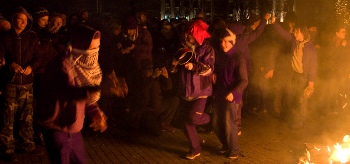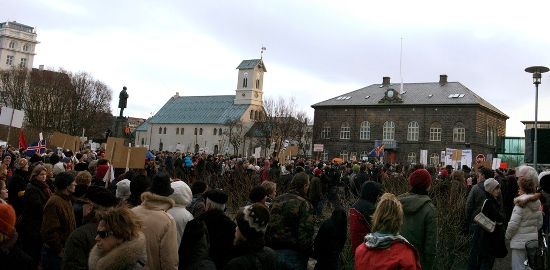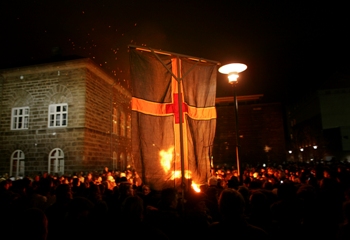Protests in the capital Reykjavik have brought thousands of people on to the streets in the biggest demonstrations the country has ever seen. As a result, the coalition government between the Samfylkingin (Social Democrats) and the Conservative Independence Party has broken up. The government of Iceland is thus the first to fall as a consequence of the present economic crisis. It will not be the last.

On Friday, the Prime Minister of Iceland, Geir H. Haarde, using poor health as an excuse, called for new elections on May 9 and said he would not be standing again. He was to remain as Prime Minister until that time. On Sunday, the Social Democratic Minister of Trade pulled out of the government after sacking the board of financial regulators. He claimed responsibility for the crisis and urged for new elections. The same day the Social Democratic deputy head of the Central Bank resigned. The Social Democratic party seemed to be pulling out of the government by the back door. On Monday, the coalition finally fell apart after a meeting between the coalition partners.
The Prime Minister claims that the Social Democrats have become uncooperative and says that the party is really three different parties. According to Haarde, the Social Democrats were demanding the office of Prime Minister, which he considered unreasonable. He also criticized the Social Democratic leadership for not having the strength to complete the coalition. What he means is that the party bent under the pressure of the masses.
Mass protests on the streets of Reykjavik
Ever since the bailout and take-over of the Icelandic banks in October, weekly protests have been taking place outside parliament organised by the "Voices of the People" movement. In the absence of a genuine leadership of the working class, a group of intellectuals and cultural personalities assumed the leadership of this movement.
The Social Democratic Party, the traditional party of the working class, was part of the discredited government that the protests were directed against and were hoping to continue with "business as usual" and appealed for national unity. The Left-Green Party, although outside the coalition, had lost itself in petty-bourgeois reformism and was taken completely by surprise when the movement began. The trade unions acted in a similar manner to the Social Democrats and originally started negotiations with the government on a new labour law. Like in so many other countries, the leadership of the working class had lost touch with the grass roots of its party.
The protests continued every Saturday throughout the autumn, attracting 2-3,000 participants. Towards the end of November, there were signs indicating that the protests were having an effect. The trade unions demanded that several ministers resign. Also throughout December young people were protesting outside the Saturday protests. On New Year's Eve demonstrators broke up a traditional television broadcast of the political parties. Then, at a congress of the liberal Progressive Party (with a base among the farmers) on 17 January, a new leader was elected who started advocating a break-up of the coalition.
The movement was not confined to protests, however. A process of discussion started amongst the participants who were trying to figure out what had gone wrong. The people want greater accountability of their leaders. They want an end to the corruption and nepotism that has made a few very wealthy and landed the rest with the bill. Much like the revolution in Venezuela which started with a call for a new constitution, the Icelanders are now demanding a say in the running of their country. In the past half-year many meetings have been held around the country discussing the economic crisis. The ministers have been invited to explain their actions, but their attempts to put the blame on the financial system and Gordon Brown have failed to stem the anger. Instead the movement has become increasingly militant and demanded the resignation of the government.

The last week
As Parliament reconvened on 19 January, they were initially prevented from meeting, as 2,000 demonstrators blocked the parliament building. The protests continued on Tuesday, Wednesday and Thursday. Violent clashes started occurring between police and young demonstrators. Although, like in Greece, the youth have dominated the protests, it is clear that they have the sympathy of the workers. Some workplaces even sent delegations to the demonstrations.
Many at the top were hoping that the Prime Minister's resignation on Friday would dampen the anger of the masses. It seems likely that his announcement was made for fear of what the Saturday demonstration would bring. Rather than dampening the mood, however, it emboldened the masses. One protester writes on her blog:
“The energy was incredible - vastly different from the strong undercurrent of anger, hopelessness and despair that has prevailed of late. It’s like our latest victory [the PM's intention to call elections] has unleashed tremendous energy and elation and yesterday’s demonstration was almost like a celebration. It was fantastic to be there, at the very centre of change and at such a momentous time in the history of our nation.” (Power to the People, The Iceland Weather Report, 25 January 2009)
The largest protest in the history of Iceland gathered some 5,000 people. The most popular slogan was "Vanhæf ríkisstjórn!" (incompetent government) and national-romantic songs were sung, claiming the right of the people to the country. Protests then proceeded into the night and on Sunday sporadic protests were held outside the offices of the Central Bank, demanding the resignation of its board of directors. Throughout the protests the PM maintained a firm position against the protests and persistently maintained that he would not resign. Yet, on Monday he did so and the rank-and-file of the Social Democratic Party played a crucial role.
The Social Democratic Party and the mass organisations
The autumn saw a rapid change in the voter preferences. The Conservative Independent Party lost a third of its voters and the Left-Green Party doubled its vote. Yet it was not at the expense of Social Democratic Party who managed to maintain its 27% of the electorate. If elections had been called at that time, the left would have held 60% of the vote. However, the leadership of the Social Democratic Party was not interested in such a prospect, preferring to maintain the present coalition and hope that the protests would die down. But the masses did not oblige them in their wishes. Instead, the protests increased and pressure started to mount inside the Social Democratic Party itself.
Like in so many other countries, the leadership of the working class is attempting to put a break on the movement; "national unity!" has been the cry of the leaders of the Social Democratic Party and their allies in the Conservative Independence Party. The type of "national unity" they have in mind is one that allows them to attack the welfare state and increase taxes to pay back the debts owed to foreign banks. The chairman of the Social Democratic Party, who was also a minister in the government, was for a long time defending the government, refusing to break the coalition.
The stance of the chairman has made the Social Democratic Party crash in the polls. As we have seen, throughout the autumn, the party managed to maintain its support in the polls to around 27%. In the latest poll, the party has lost half of its supporters to the Progressive Party, whose chairman was supporting a break-up of the coalition.
A party in crisis
The rank-and-file of the party proceeded to act. A meeting of the Reykjavik branch of the party on Tuesday called for a break up of the coalition and new elections this spring. The vice-chair of the party had been pushed into more or less open conflict with the chair of the party, when he supported the demand for new elections, saying that the party “should not fear the nation”. At the meeting, one participant called for all the MPs of the party to resign and received loud applause from the meeting. The Reykjavik branch represents the vast majority of the members and this split in the leadership of the party is the result of pressure from the workers who still are the base of the party.
On Thursday, Ingibjörg Sólrún Gísladóttir, the chair of the Social Democrats, started to make noises to the effect that new elections would be required. Then on Friday, the Social Democratic ministers most likely put pressure on the Prime Minister to call elections and resign. Subsequently, as we have seen, two leading Social Democrats resigned, the Minister for Trade and the vice-chair of the Central Bank, the former proceeding to attack the government and call for new elections.
Thus an open conflict has erupted inside the Social Democrats between the right wing that supports coalition with the Conservatives and a left wing that most likely will move towards the Left-Green Party. The criticism of PM Haarde that the party is split in three and that it cannot fulfil its obligations must be seen in this light. The ruling class is concerned about the fact that the Social Democrats, after years of loyally serving the interests of the ruling class, is now feeling the pressure of the masses and having to give it some form of expression!
The Left-Green Party also moved to the left over Christmas and their MPs came out in open support of the movement, even joining the demonstrations. Yet, as a result of their failure to participate in the early stages of the movement they got sidelined from the protests, even though their figures in the polls increased dramatically.
An economy in free fall
According to estimates by The Economist, the Icelandic economy is going to contract by at least 10% in 2009, with unemployment growing ten-fold. The currency has fallen by 40%, bringing prices of imported goods up dramatically. This represents a heavy attack on living standards.
Furthermore, personal debt, as in many other countries, have increased tremendously in the last period, driven by inflated house prices. Easy access to 100% mortgages has brought many young people into heavy debt, which they are now struggling to repay. The situation is made even worse by the widespread practice of loans linked to inflation and loans denominated in Euros. 20% inflation means a 20% increase in the debt of all Icelanders with inflation-based loans and the 40% fall in the currency value means that anyone with loans in Euros have seen their debt increase by two thirds. The prospects for the Icelandic economy are grim. No wonder that people are angry at the politicians who have stood by and let this happen.
Government borrows to bail-out the banks
Government debt is set to increase from 29% to 109% of GDP. That means that the banking crisis has cost the Icelanders 80% of everything that is produced in the country for a year. Half of this is to go towards repaying the debt accumulated by the banks in the past period. 25% of GDP is to be spent on "recapitalising the banks", i.e. replacing the money that they spent on repaying loans last year. Another 10% of GDP is going to be spent on the Central Bank, whose foreign currency reserves have been depleted by the banking crisis. It is possible that some of this money can be covered through the sale of companies that the banks own but in the present economic situation, those assets are likely to decrease in value.

The deficit in the government budget is estimated to be 10% of GDP next year, increasing debt by the same amount. The IMF is not pressing the government to repay the loans next year but in 2010 they want the government to start cutting back on spending or increasing taxes - making the Icelanders pay for the crisis. Paul Thomsen, director of the IMF, comments that “It could be the most expensive bank restructuring that the world has ever seen relative to the size of the economy.”
The Icelandic politicians are keen to play down the effects of the crisis, with a spokesperson for the prime minister claiming that they are “fairly confident that we will have the resources so that people can maintain a reasonable standard of living while we are going through the worst.” Yet the figures speak for themselves: the repayment of these loans will mean nothing but higher taxes and cuts in public services - an attack on the living standards of the people of Iceland that will continue for years to come.
Let the bankers pay for the crisis!
The foreign debt owed by Iceland was not incurred by the people of Iceland. The debt is not the result of the purchasing of lavish luxury cars or investment in public services. It is the result of the speculation of a tiny clique within the population, who are now fleeing the country to their luxury homes abroad. And now the multinational banks want the people of Iceland to pay for the mess made by this tiny minority of super-rich.
The bankers should pay for the crisis, not the people! The bankers in Britain, Germany and the Netherlands should collect their debts from their colleagues in Iceland, who have now fled the country. Why should the people of Iceland suffer for the mistakes of a tiny minority?
A socialist programme
The Social Democratic Party and the Left-Green Party need to put forward a Socialist Programme. The only way forward for the workers and youth of Iceland now is on the basis of socialism. Let the bankers pay for the crisis! Take over all of the remaining companies of the financial speculators. Why should they keep the profitable businesses whilst the government takes over the unprofitable banks? Mortgage repayments must be set at a reasonable level. Let those who cannot pay their mortgages stay in their homes. On the basis of a programme of such demands, the Social Democratic Party and the Left-Green Party would be able to win the election and ensure the living standards of the workers.
The Icelandic revolution
The hope of the Icelandic ruling class is that the movement will lose momentum and that a new government will be able to calm the situation. However, such a development is unlikely. In fact, the attempts to enforce wage freezes by the employers’ association and cuts in the welfare state at the same time as the cost of living is rising is a finished recipe for class struggle. The struggle that took place this winter over the new government is only the beginning of more militant struggles to come.
In spite of its small size, the people of Iceland have the opportunity of giving the peoples of Europe an example. They could go down in history as the vanguard of the European revolution. Already the ruling classes of Europe are looking with horror at events in Iceland. But so are the workers. The government of Iceland is the first one to fall in Europe as a result of the crisis of capitalism but it will not be the last. The brave actions of the Icelanders will embolden the workers of other countries to follow suit.
Already we have seen how the Social Democratic Party, the Left-Green Party and the unions have been pushed to the left. This is only the beginning. In order to fight to maintain living standards, workers will need to transform their organisations into fighting organisations. The only way this can happen is through the building of a Marxist tendency within the ranks of the labour movement organisations.
Let the bankers pay for their own mess!
No to lay-offs! Work for all!
No to the outrageous increases in mortgage repayments!
For a left government on a socialist programme!
See also:
- Iceland – what happened? by Jack Smart (October 28, 2008)
